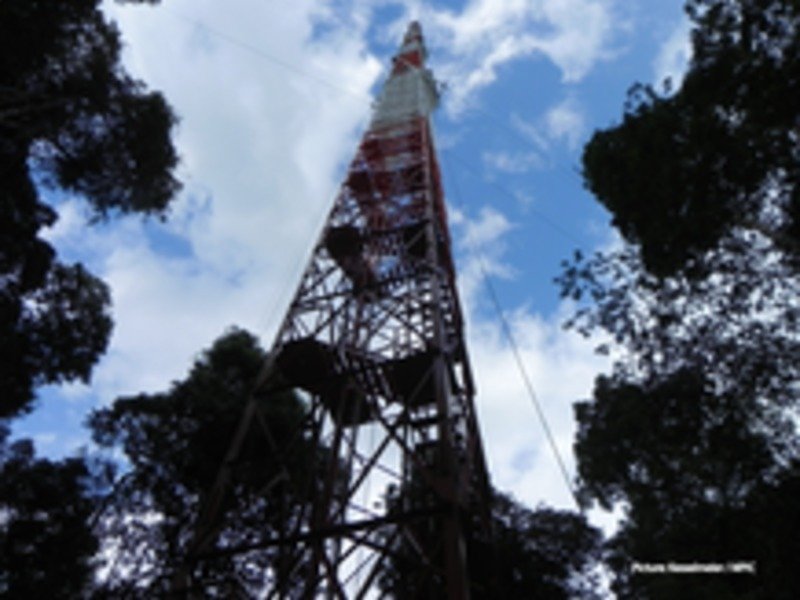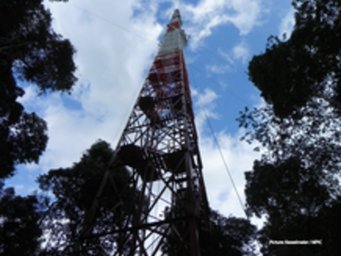ATTO inauguration ceremony in the Brazilian rain forest
The Brazilian National Institute of Amazonian Research, the University of the State Amazonas and the Max Planck Society are opening a 325 meter high measurement tower in the Amazon rain forest
One hundred fifty kilometers northeast of Manaus in the middle of the densest Brazilian rain forest stands the Amazonian Tall Tower Observatory, ATTO. After one year of construction, ATTO will be officially inaugurated on Saturday, August 22, 2015. The 325-meter-high measurement tower is a joint project between Germany and Brazil coordinated by the Max Planck Institute for Chemistry, the Max Planck Institute for Biogeochemistry, the Brazilian National Institute of Amazonian Research, INPA (Instituto Nacional de Pesquisas da Amazônia), and the University of the State of Amazonas, UEA (Universidade do Estado do Amazonas). In addition to representatives of these research centers, the Brazilian Minister of Science, Technology and Innovation, Aldo Rebelo, the Governor of the State of Amazonas, José Melo, and representatives from the German embassy in Brazil will be traveling to the inauguration ceremony.
High above the treetops of the rain forest, modern measuring equipment will collect data about greenhouse gases, aerosol particles, cloud properties, boundary-layer processes, and the transport of air masses every day. "With ATTO we are achieving a milestone in the research of the Earth system. All the data that we are generating with this new measuring tower is being incorporated into models to predict climate development," explains Ferdi Schüth, Vice President of the Max Planck Society, with a view to the inauguration. As a result, emphasizes Schüth, the research arising from ATTO measurements will help policymakers in the future to further develop environment policy regulations and global climate targets.
"We designed the ATTO project as a world reference laboratory for interactions between tropical rainforests with the atmosphere. The results will provide a major advance in the representation of tropical rainforests in meteorological and Earth system models to generate much more accurate weather forecasts and scenarios of future climate", explained the INPA's scientist Antonio Manzi, the Brazilian coordinator of the ATTO project.
"In addition, Brazil-side partners, especially those in Amazonia, have emphasized that the greatest legacy of the ATTO project for the Brazilian community should be the expertise - both knowledge transfer and training - that can be transferred through the joint work between Brazilian and foreign scientists and students", commented Rodrigo Souza, professor at UEA.

Far away from human influences
"We chose the location in the Brazilian rain forest as it is largely situated away from human influences and therefore guarantees relatively unperturbed data," explains Meinrat O. Andreae, Director of the Biogeochemistry Department at the Max Planck Institute for Chemistry, the institution that is responsible for coordinating the German contribution to the joint project. ”Furthermore, ATTO will allow scientists to carry out their measurements in higher layers of the atmosphere and more continuously than before, so that more reliable statements about the development of our atmosphere are to be expected,” continues Andreae.
From the top of the measurement tower researchers can also trace the changes in air masses triggered by crossing large areas of forest. By analyzing these interactions they want to gain knowledge about the importance of the rain forest for the atmosphere's chemistry and physics.
The scientists on site are still busy installing the measurement equipment on the tower but the first data will soon be collected and analyzed. The scientists' specific aim is firstly to better understand the sources and sinks of greenhouse gases such as carbon dioxide, methane, and nitrous oxide. “We also do not yet adequately understand the role that the rain forest plays in the formation of aerosol particles and therefore in cloud formation. A whole range of secrets is waiting to be discovered using our new measurement tower," says Jürgen Kesselmeier, Project Coordinator at the Max Planck Society, summarizing the many hopes placed on ATTO.
Investment shared by Brazil and Germany

Luiz R. França, the Director of The Brazilian National Institute of Amazonian Research, INPA, points out: “This fascinating scientific joint venture is a clear illustration of how a giant task that benefits the entire planet and humankind, can be developed when two great countries, located in different and far away continents, work together in symphony. Our knowledge about the Amazonian region and the earth will not be the same when this magnificent and impressive enterprise is in full operation”.
The costs of roughly 8.4 million € for the construction of ATTO and the first five years of operation are being shared by Germany and Brazil. In Germany the project is financed by the Federal Ministry of Education and Research (BMBF) and in Brazil by the Federal Ministry of Science, Technology and Innovation and the Government of Amazonas.
Earth System Research at the Max Planck Society
At the Max Planck Society research into the Earth system is a key focus, in the form of the collaborative research of the Max Planck Institutes for Chemistry, Meteorology, and Biogeochemistry. This last institute also operates the tall tower ZOTTO in the Siberian taiga since 2006, among others around the world. SB/JE

